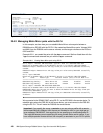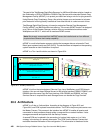458 IBM System Storage DS6000 Series: Copy Services with IBM System z
30.1 Introduction
eRCMF is a scalable and flexible solution that protects business data and maintains
consistent data. It can be used to manage copy relationships for:
Planned outages such as hardware and software upgrades, or disaster practice
Unplanned outages such as an actual disaster
The solution provides basic commands through the FO/FB Session Manager Proxy, which
utilizes the ESS Open API functions to accomplish either a planned or unplanned FO/FB
sequence. eRCMF commands can be incorporated in any user scripts or utilities that may
further link users’ overall data center operations. However, the users are responsible for
creation, maintenance and any liabilities associated with such scripts or utilities. Therefore,
eRCMF offers a simple way to implement Remote Copy disaster recovery procedures via
command line. eRCMF applies the commands to a set of configuration files that describe the
disk subsystem configuration (paths and sets of volumes).
The solution does not depend on the operating system because no client installation is
required.
30.1.1 Solution highlights
The eRCMF solution highlights and benefits are summarized in the following list. It:
Provides automation capability.
Simplifies disaster recovery operations.
Improves protection of critical business data, guaranteeing data consistency and ensuring
restart capabilities.
Avoids human errors.
Reduces risk of downtime.
Lets you stay competitive, maintaining market readiness by managing risk more
efficiently.
Enables test and practice of disaster recovery setup regularly.
Reduces testing risk.
Provides a central, scalable, flexible enterprise class solution that protects your business.
Simplifies the configuration:
– Offers a simple configuration description.
– Provides tools to verify the configuration.
Simplifies the utilization with simple commands to fix problems.
Needs no predefined Copy Services tasks.
30.2 Overview
In a Business Continuity solution based on disk remote mirroring, we want to restart a
database application following an outage without having to restore the database. This
process has to be consistent, repeatable, and fast: measurable in minutes.
A Database Recovery, where you have to restore the last set of Image Copy tapes and apply
the log changes to bring the database up to the point of failure, is a process that can be
measured in hours or even days. And this is what you want to avoid in a Tier 4 or higher


















